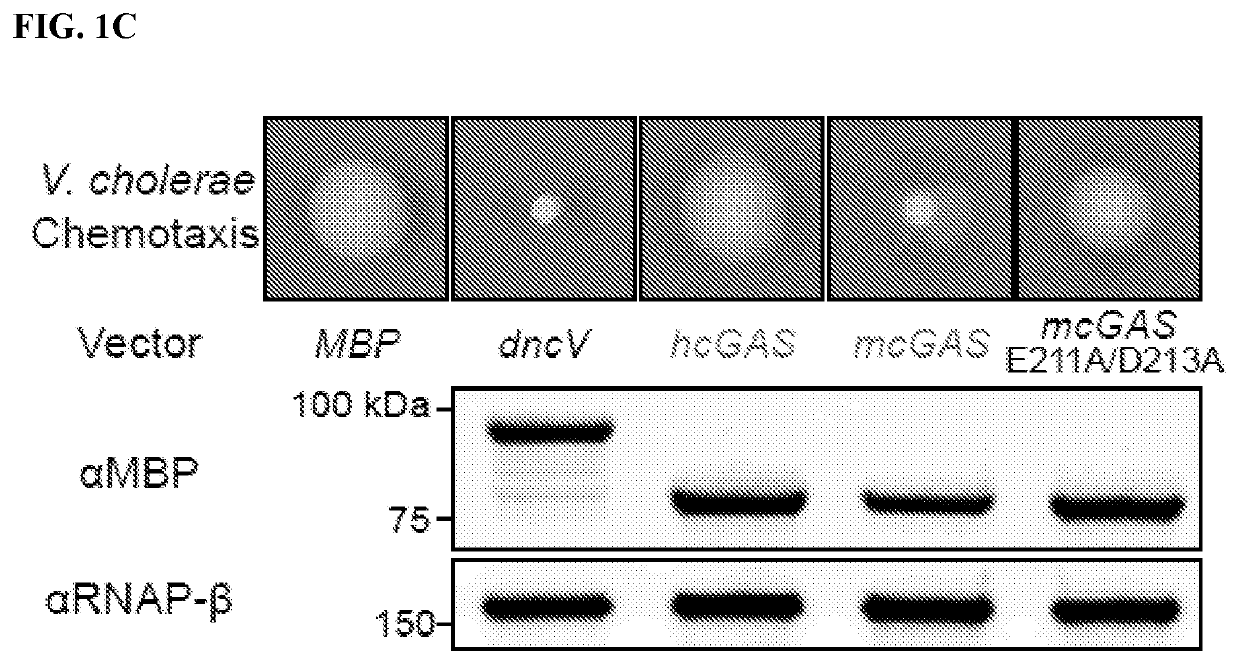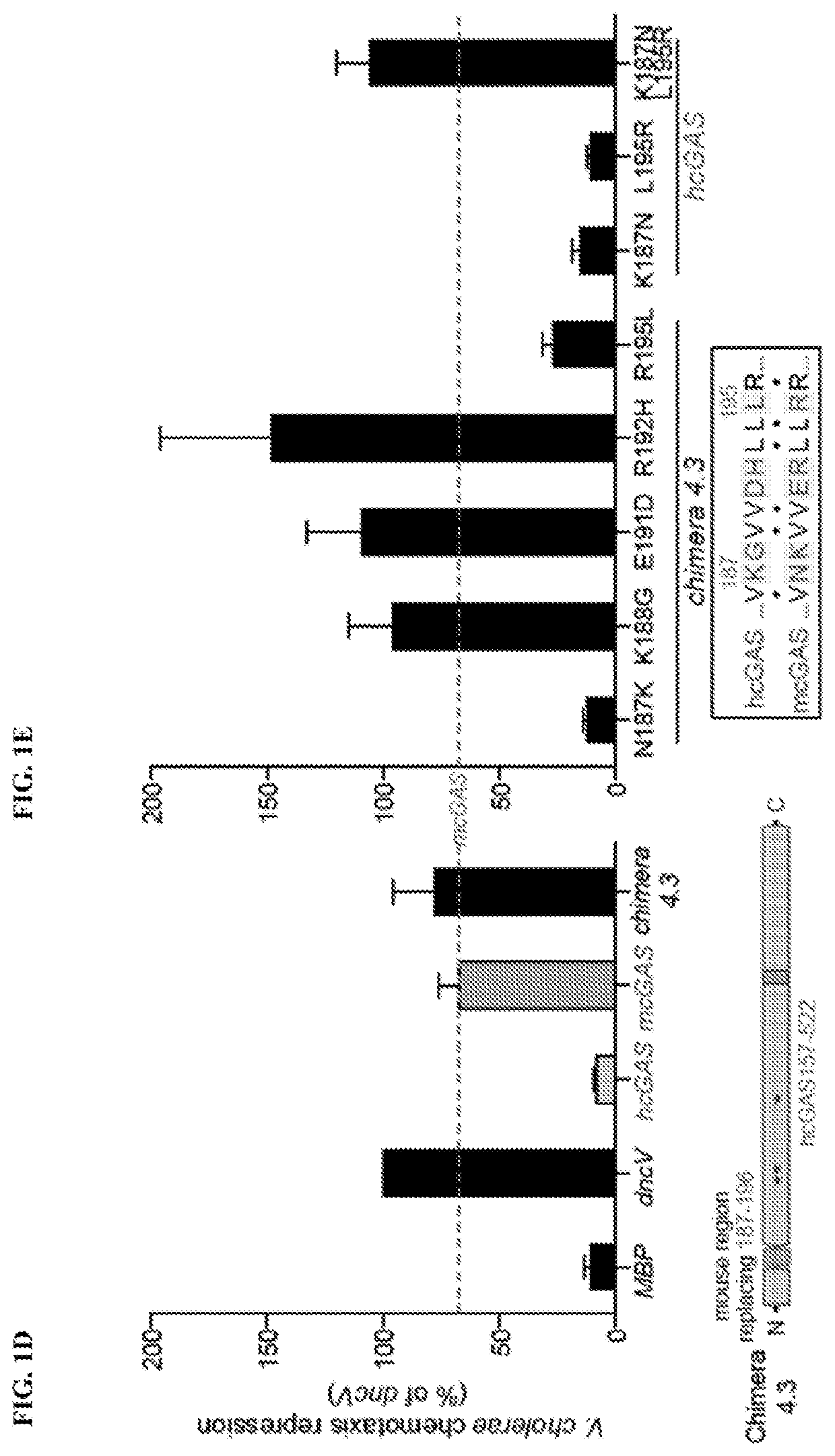Structure of the human cgas-dna complex and uses thereof
a technology of cgas and complex, which is applied in the structure field of the human cgasdna complex, can solve the problems of severe autoimmunity, no structural information exists for activated human, and the ability of human cgas to synthesize 2′3′ cgamp is severely reduced
- Summary
- Abstract
- Description
- Claims
- Application Information
AI Technical Summary
Benefits of technology
Problems solved by technology
Method used
Image
Examples
example 1
and Methods for Examples 2-6
[0338]a. Protein Expression and Purification
[0339]Human cGAS (encoding residues 157-522) and mouse cGAS truncations (encoding residues 147-507) were PCR amplified from previously described plasmids (Diner et al. (2013) Cell Rep 3:1355-1361; Kranzusch et al. (2013) Cell Rep 3:1362-1368) and cloned into a custom pET vector for expression of an N-terminal 6×His-SUMO2 fusion protein in E. coli. E. coli BL21-RIL DE3 (Stratagene) bacteria harboring a pRARE2 tRNA plasmid were transformed with a pET cGAS plasmid. Transformations and starter cultures were grown in MDG media (0.5% glucose, 25 mM Na2HPO4, 25 mM KH2PO4, 50 mM NH4Cl, 5 mM Na2SO4, 2 mM MgSO4, 0.25% aspartic acid, 100 μg mL−1 ampicillin, 34 μg mL−1 chloramphenicol, and trace metals) overnight at 37° C. and used to seed 1 L cultures grown in M9ZB media (0.5% glycerol, 1% Cas-Amino Acids, 47.8 mM Na2HPO4, 22 mM KH2PO4, 18.7 mM H4C1, 85.6 mM NaCl, 2 mM MgSO4, 100 μg mL−1 ampicillin, 34 μg mL−1 chlorampheni...
example 2
enetic Assay in Bacteria Maps the Molecular Determinant of Human-Specific cGAS Regulation to Two N-Terminal Substitutions
[0369]Cyclic GMP-AMP synthase (cGAS) recognition of cytosolic DNA is critical for immune responses to pathogen replication, cellular stress, and cancer. Existing structures of the mouse cGAS-DNA complex provide a model for enzyme activation, but do not explain why human cGAS exhibits severely reduced levels of cyclic GMP-AMP (cGAMP) synthesis compared to other mammals. Previous results demonstrate that hcGAS produces less 2′ 3′ cGAMP than mcGAS (Sun et al. (2013) Science 339:786-791). A critical feature of human cGAS-STING signaling is the preferential response of human cells to long (>45 bp) cytosolic DNA (Andreeva et al. (2017) Nature 549:394-398; Karayel et al. (2009) Eur J Immunol 39:1929-1936; Luecke et al. (2017) EMBO Rep 18:1707-1715; Stetson and Medzhitov (2006) Immunity 24:93-103). To better understand human-specific regulation of cGAS activation, cGAS ac...
example 3
l Basis of K187 and L195 Substitutions Controlling hcGAS Activity
[0373]The impact of hcGAS K187 and L195 substitution on enzyme activity was dissected using a panel of eight recombinant cGAS enzymes and direct measurement of 2′3′ cGAMP synthesis. Analysis of all possible combinations of K187 / N187 and L195 / R195 substitutions in both hcGAS and mcGAS backgrounds revealed a clear pattern showing that human-specific substitutions reduced total 2′3′ cGAMP output (FIG. 5A). The presence of K187 and L195 resulted in reduced enzyme activity (as compared to N187 / R195) in both the hcGAS and mcGAS backgrounds, and a double K187 / L195 mutation fully restrained mcGAS 2′3′ cGAMP synthesis to human levels. The structural basis of how K187 and L195 controlled enzyme function was next determined. All previous efforts in the field to determine the structure of hcGAS bound to activating DNA have been unsuccessful. However, using hcGAS K187N / L195R and a 17 bp activating DNA, it was now able to identify c...
PUM
| Property | Measurement | Unit |
|---|---|---|
| Lattice constant | aaaaa | aaaaa |
| Lattice constant | aaaaa | aaaaa |
| Fraction | aaaaa | aaaaa |
Abstract
Description
Claims
Application Information
 Login to View More
Login to View More - R&D
- Intellectual Property
- Life Sciences
- Materials
- Tech Scout
- Unparalleled Data Quality
- Higher Quality Content
- 60% Fewer Hallucinations
Browse by: Latest US Patents, China's latest patents, Technical Efficacy Thesaurus, Application Domain, Technology Topic, Popular Technical Reports.
© 2025 PatSnap. All rights reserved.Legal|Privacy policy|Modern Slavery Act Transparency Statement|Sitemap|About US| Contact US: help@patsnap.com



